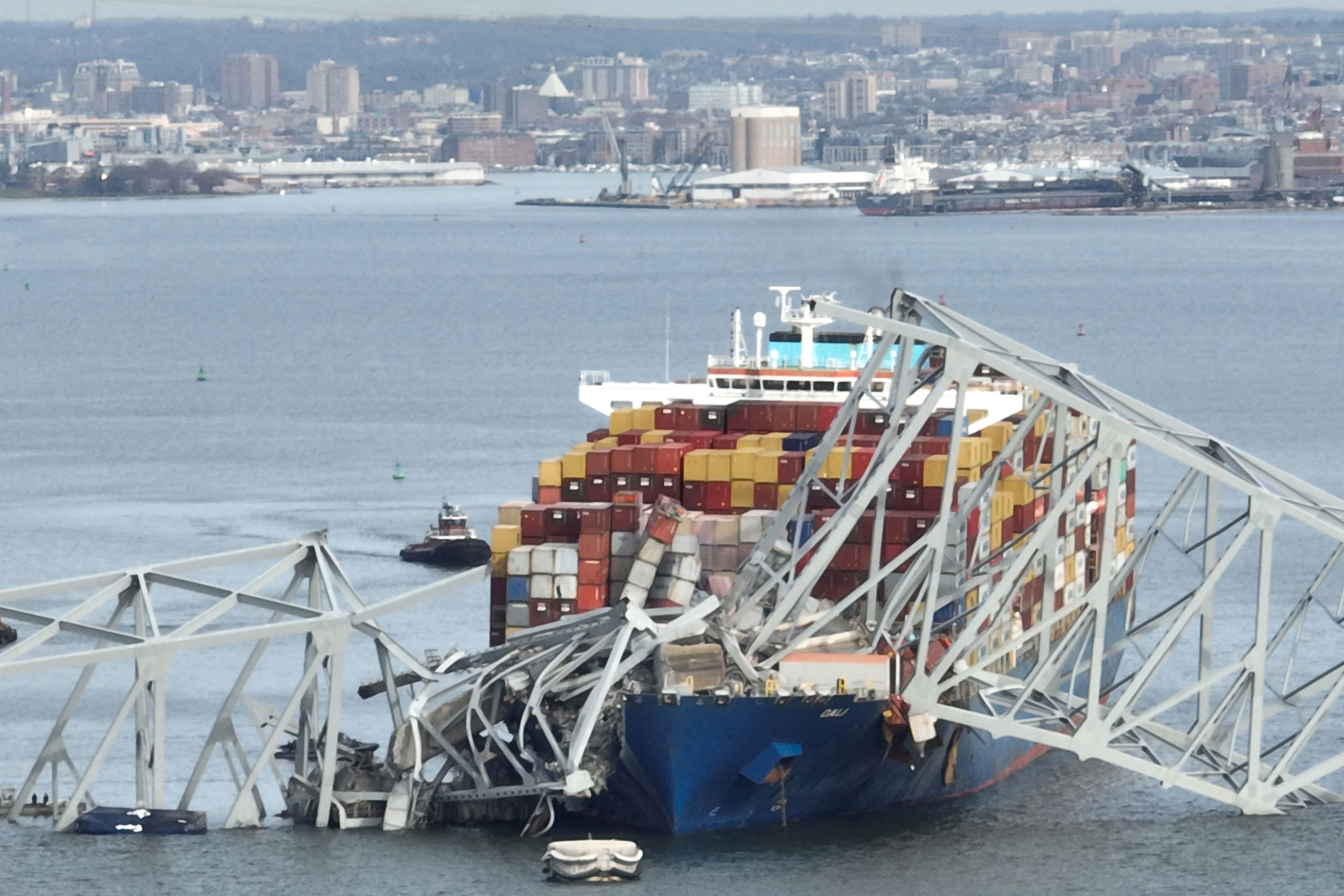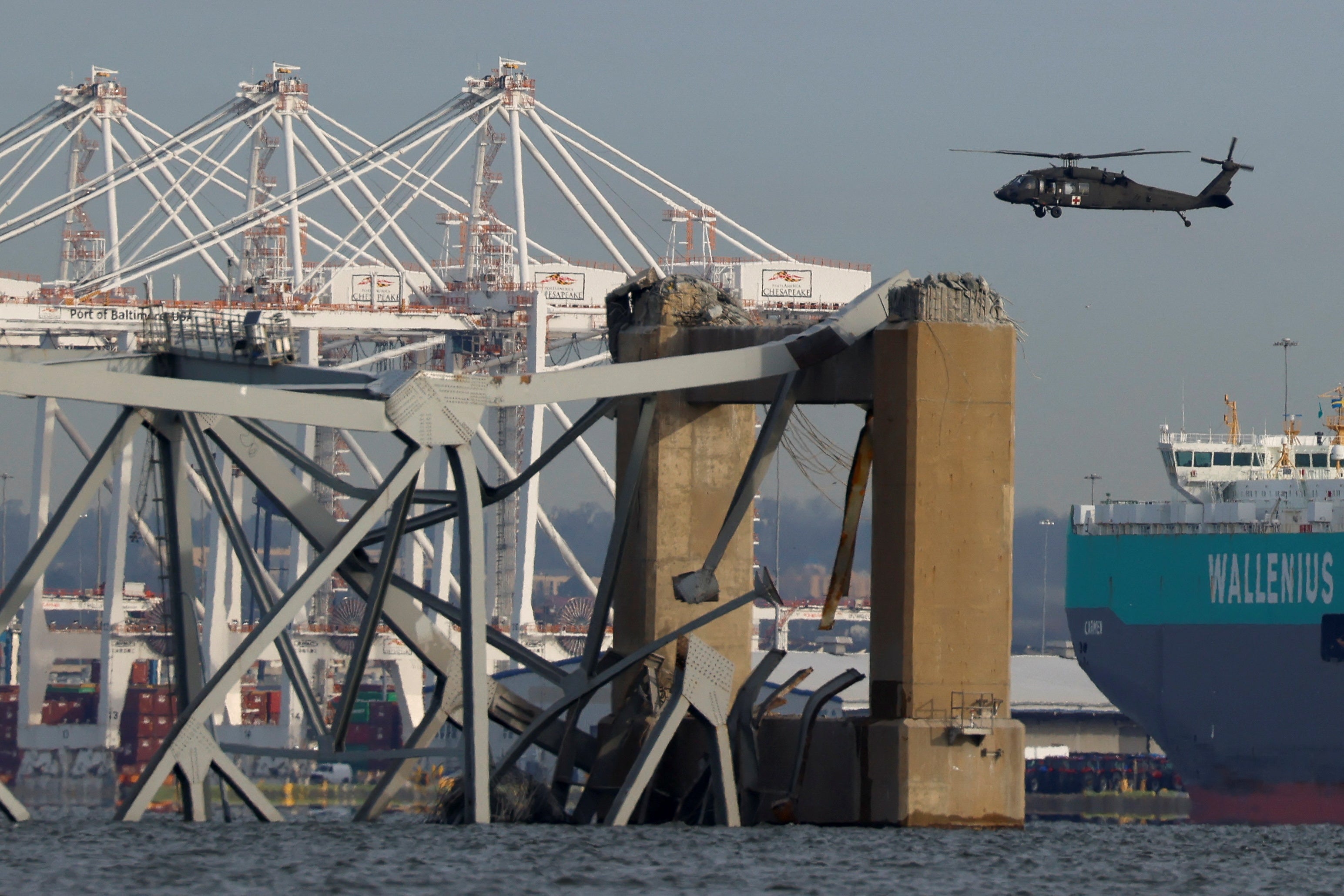A huge shipping vessel that collided with a major bridge in Baltimore has left numerous people missing and could cause significant economic and social disruption, experts say.
Many questions remain about the collision, including why the ship hit with the bridge in the first place. But many of them are structural: how was the ship able to reach the bridge, why was it not protected against such collisions, and why the bridge collapsed so quickly once the collision had happened.
Experts say it may be too early to say exactly what happened during the collision and the collapse that resulted. But they caution that bridges of this kind are specifically built with protections against such crashes – and that it may have required a huge impact to make the bridge fall in this way.
Bridges have collapsed from collisions with ships before. Between 1960 and 2015, there were 35 major bridge collapses that happened after they were hit by a marine vessel, said Toby Mottram from the University of Warwick.

(AFP via Getty Images)
That ever-present danger means that modern bridges are built specifically with such collisions in mind. Engineers have developed a range of requirements and safety solutions aimed at securing the integrity of the bridge even in the case of the collision.
Bridges of this kind – large, and crossing shipping lanes – are required to protect the piers or columns that hold them up. Those protections come in a variety of different forms, said Robert Benaim, a bridge designer and fellow of the Royal Academy of Engineering.
“These protections are either in the form of structural protections like ‘sacrificial dolphins’, which are made of steel and embedded in the seabed to stop or divert a ship. They can also be in the form of artificial islands; these are for very large ships and mean the ship will never reach the bridge pier itself.”
The Francis Scott Key Bridge is relatively modern, so experts would expect that it was built with the assumption that its supporting piers might experience a collision. Those piers are important because any structural failure in them – especially in the centre – means that the whole bridge would collapse.
But those protections only go so far. “A vessel’s mass and velocity are key factors in the level of impact force generated and there is an economic and practical limit to what level of impact force can be designed for,” said Lee Cunningham, a reader in structural engineering at the University of Manchester. “Similarly, the direction of impact is also an important factor and design assumptions for this would likely be based on the position of the dedicated navigation channel.”
In the case of the Francis Scott Key Bridge, its design in the 1970s might not have taken account of the vast size and power of the ships that sail under it today. The ship that collided with the bridge – the ‘Dali’ – was vast, at 300 meters long and 48.2 meters wide, loaded with huge amounts of cargo and travelling at a still unknown speed.

(via REUTERS)
“It’s conceivable that the piers weren’t designed to withstand the magnitude of today’s ship impacts, as vessels like the ‘Dali’ weren’t navigating the Port of Baltimore during that era,” said Professor Mottram. “Despite meeting regulatory design and safety standards of the 1970s, the Baltimore Key Bridge may not have been equipped to handle the scale of ship movements seen today.”
But, Professor Mottram noted, it is not only the technologies in the bridge that should help avoid such a disastrous collision. “Modern navigation technologies should have prevented the ship from striking the pier,” he said, noting that a priority of the investigation will be finding out how those technologies failed on the ship.
One remarkable thing about videos of the collapse is the speed at which it happens: once the bridge begins to buckle, it quickly falls away entirely. That is in part because it is built as a “continuous truss bridge”, made out of long steel truss that goes across the three main spans, rather than having connections on the piers.

(REUTERS)
““The collision of a vessel as large as the Dali container ship will have far exceeded the design loads for the slender concrete piers that support the truss structure, and once the pier is damaged you can see from the videos that the entire truss structure collapses very rapidly,” said Andrew Barr, a research fellow in the Department of Civil and Structural Engineering at the University of Sheffield.
“This is an example of what engineers call progressive collapse, where the failure of one structural element leads to the failure of neighbouring elements, which can’t support the new loads placed on them. In this case, the collapse of the pier caused the now unsupported truss above it to buckle and fall. Because this is one continuous truss, the loads are redistributed – the truss pivots around the surviving pier support like a seesaw, temporarily lifting the northern span into the air before the high tension forces cause this to fail too, and the whole truss collapses into the water.”
Dr Barr noted tha tthe video itself will be “incredibly useful to the teams” assessing the collapse, since they would otherwise have to rely on the remains of the structure and models.
The Independent is the world’s most free-thinking news brand, providing global news, commentary and analysis for the independently-minded. We have grown a huge, global readership of independently minded individuals, who value our trusted voice and commitment to positive change. Our mission, making change happen, has never been as important as it is today.
News Related-
Antoine Dupont still hurt by 'injustice' of World Cup loss to Springboks
-
China's New Aircraft Carrier Begins Catapult Testing
-
Aircraft Downed Inside Russia By Patriot System: Ukrainian Air Force
-
“Am I Prog’s Taylor Swift? That’s a debate that could run and run”: why Peter Hammill re-recorded his Enigma-era albums
-
Car With Pro-Russian Fighters Blown Up by Resistance: Exiled Mayor
-
Europe and African nations must find effective common ground in dealing with migration influx
-
Springbok lock opts not to renew contract with URC team
-
Pravin Gordhan’s deathly legacy: A threat to SA’s economic future
-
Antoine Dupont STILL hurt by ‘injustice’ of Rugby World Cup loss to Springboks
-
Rubber stamping NHI Bill will have damaging consequences for SA for generations
-
Inside horrific conditions Hamas hostages suffered including losing 15lbs in 50 days
-
After the Bell: SA’s NHI healthcare disaster starts right here
-
Gupta-linked development land for sale
-
Gary Neville begrudgingly claims brilliant Man Utd midfielder ‘looked like a Man City player’ in Everton mauling
